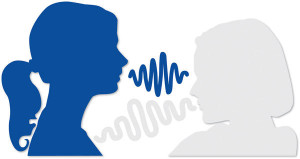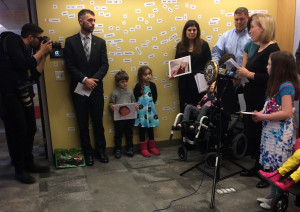My Epilepsy Story
I recall the day I had my first seizure very well. I was walking into the room where a school-wide mass was taking place when suddenly, as the music began, I became very anxious. Everything seemed to be in slow motion – even the music slowed down and I started to shake. I did everything I could to continue standing but the pain was too great. I slowly dropped to the floor. At one point, I thought I was dying (I thought this was the end). I woke up to the comforting smiles of my middle school’s vice-principal and nurse. My body was physically drained. They told me I had a seizure.
What was a seizure? For someone who had no bad medical history, why me? The shock of the diagnosis of Epilepsy was a bit overwhelming in and of itself, but then I had to learn all about it. All of it seemed so surreal. Over the next two years I went through countless seizure-drug combinations, some of which drastically changed my mood. At one point, brain surgery was discussed.
I was already struggling with anxiety but the diagnosis only made things worse. I constantly would wonder “When would my next seizure happen?” I was terrified. Seizures didn’t just affect me physically, they affected me emotionally and socially. During Middle School, I was nervous when I wasn’t around an adult. Also, I felt other students didn’t really understand me, some were even scared to have me around. There was always a sense of guilt and that I just caused ‘extra work’ for everyone; often I just wanted to disappear.

In the 9th grade I starting to become very socially withdrawn and didn’t feel accepted. I began to spend more time composing and engineering music, whether it be in the hospital, my room or a local studio. I caught a break and started working with major songwriters and recording artists, while continuing school. Throughout high school, I only had a few people I could confide in. There aren’t a lot of people who will understand those daily struggles. Most never saw the tears or the endless nights in the hospital.
When I graduated June 2014, my seizures were finally controlled by medication. I recently started college, focusing on graphic design, while continuing on music collaborations. I consider myself extremely blessed to have had great support from family, teachers, doctors and school nurses.
My dream is to create a career in the arts, one that will help inspire other struggling artists to persevere and push beyond the seemingly hopeless circumstances they sometimes face in life.
Growing-Up With Epilepsy and Learning to Speak Out at School and in the Workplace
Epilepsy is difficult to explain, describe and understand. People can only “see” epilepsy when someone is having a seizure. For many people with epilepsy, seizures are unpredictable and, sometimes, undetectable to others. In my case, most of my seizures have been tonic-clonic, or grand-mal, seizures. Tonic-clonic seizures are hard to miss. However, unless I’m having a violent seizure, no one would know I have epilepsy, until I open my mouth. I talk a lot about my epilepsy. Communicating with others about my epilepsy keeps me safe and helps me take control. As a person with epilepsy, I force myself to keep an open and honest dialogue with all of my medical professionals, my peers and my work colleagues.
I was five when first diagnosed with epilepsy after having absence, or petite-mal, seizures. At the time, I did not mind the epilepsy diagnosis because my seizures were not visible to me. Then, I learned I had to take monthly blood tests…with needles! I dreaded blood tests and I did not go softly or quietly into the pathology lab. It was stressful for me; every time I knew I was getting another blood test I would start crying and screaming. Finally, a lab technician took a moment to speak with me. I expressed to him my fear of needles. He offered to take my blood with a smaller needle he called a “butterfly,” and it would not hurt as much. I agreed to cooperate calmly. One conversation changed my entire attitude towards blood tests and my behavior at the lab. The recommended “butterfly” needle might have reduced the physical pain, but in hindsight, it was the technician who calmed me down by communicating with me and addressing my fears. At the age of six, I found power and control by openly communicating with all of my doctors and medical professionals.
 My first tonic-clonic, or grand-mal, seizure happened when I was in junior high school. Epilepsy is a difficult thing to openly discuss, especially during those awkward adolescent years. After many in-class seizures, I realized it was difficult and scary for my peers to witness one of my seizures. So, I took responsibility, and talked openly about my epilepsy. There were some students who used my epilepsy as a way to bully and tease me. A few kids called me “seizure girl.” I endured other unpleasant instances of bullying targeted at my epilepsy. Fortunately, I did not care about the opinion of those who bullied me. They did not want to communicate; they wanted to attack.
My first tonic-clonic, or grand-mal, seizure happened when I was in junior high school. Epilepsy is a difficult thing to openly discuss, especially during those awkward adolescent years. After many in-class seizures, I realized it was difficult and scary for my peers to witness one of my seizures. So, I took responsibility, and talked openly about my epilepsy. There were some students who used my epilepsy as a way to bully and tease me. A few kids called me “seizure girl.” I endured other unpleasant instances of bullying targeted at my epilepsy. Fortunately, I did not care about the opinion of those who bullied me. They did not want to communicate; they wanted to attack.
My seizures were controlled during high school. Although my epilepsy wasn’t visible, my parents and doctors strongly encouraged me to continue to disclose my condition. I often had to explain to friends I did not go to concerts because most concerts have strobe lights, a trigger for seizures. After I turned sixteen, I knew communicating my health issues was a legal and ethical responsibility as a licensed driver. I was becoming an adult and I needed to learn to talk about my epilepsy independently from my parents and pediatric doctors.
In my early twenties, I started having seizures, again. I was new to the New York City workforce and I knew little about how to talk about my disorder in the workplace. I never knew when to disclose my condition or who to disclose my condition to. As an adult, communicating about epilepsy, or any disability, in the workplace can be a grey area. I did not know if I should mention my epilepsy before or after I interviewed for a new job. Most companies do not encourage people to ask others their health issues, due to privacy laws. At twenty-seven, my epilepsy was uncontrollable and I needed to change my medications (AEDs). At the time, I was having seizures at work and felt devalued as an employee, even though I had a better attendance record than many of my colleagues. In fact, I had a superior criticize me via email for not drinking and socializing at an after-hours company event. I realized the people I was working with did not want to communicate openly and honestly about my epilepsy. Like the bullies in junior high, I stopped communicating with them. Instead, I communicated with my doctors and a lawyer. I filed for the Family Medical Leave Act. This provided me some short-term job protection. It also gave me a chance to stand up for myself against employers and colleagues who tried to exploit my condition as a weakness. My epilepsy is a neurological disorder, not a weakness.
I am still figuring out the best way to live and work openly as a person living with epilepsy. Luckily, I have connected with the Epilepsy Foundation of Metropolitan New York to learn more. The EFMNY provides tools to help facilitate communication and understanding about epilepsy. It provides New York City’s only specialized job development and vocational services program for people with epilepsy. Few people understand epilepsy and epilepsy’s far-reaching effects on a person’s life. So, as a person with epilepsy, I find it easier to tell others about my condition. People are sometimes afraid to ask questions about a disability or condition out of fear of being offensive or sounding stupid. So, I try to beat them to the punch and talk about my epilepsy first. It is important to help educate, explain and remove the stigma. I will never have complete control over my epilepsy, but I have complete control over my conversations about epilepsy.
-Alexandra DeBourcy, Mrs. Gotham City
Me and My Epilepsy – Mrs. Gotham City
My name is Alexandra DeBourcy and my epilepsy is a part of my life, my history and my future.
I was diagnosed with epilepsy at the age of five, when my parents noticed I was having “head tics.” Shortly after starting my epilepsy medication, I stopped experiencing myoclonic tics. As a 5 year-old, I did not understand the full extent of my diagnosis, but I recognized a change in my lifestyle. At that very young age, I had to swallow non-chewable prescription medication, undergo many boring diagnostic tests and take monthly blood tests. The blood tests were the worst. Even at five, I knew my epilepsy diagnosis was changing my life.
Despite years of living seizure-free, one day during class when I was in the 7th grade, I had my first ever grand-mal seizure. When I awoke, I was still in school, surrounded by working paramedics, as well as teachers and school administrators whose faces were filled with panic and fear. It took me a while to understand I had just had a seizure. At the time, I could only think about how my peers, who also witnessed my seizure, would judge me. Prior to returning to school, I called some of the students in class. It was easier to explain my epilepsy on a one-on-one basis. It helped. I don’t know if my phone calls helped any of my classmates, but it I do know it helped me. It gave me strength to face my schoolmates. I had more grand mal seizures in school during my adolescence, but I continued to open up and discuss my epilepsy with classmates and adults.
Luckily, I remained seizure free during high school and most of college, but my epilepsy was still a part of me. My parents and doctors reinforced the need for me to communicate my disorder to my friends, teachers and professors. No matter how long I went without a seizure, I had a different lifestyle than my peers. I was approaching the age where my actions, especially as a driver, had a greater effect on the lives of others. So, I continued to use communication, and levity, to introduce my epilepsy to other people.
After graduating from Syracuse University, I started having grand-mal seizures, again. This added additional considerations, as I was about to begin my career search. My epilepsy stabilized, and I moved to New York City. I loved New York City, and it had a public transportation system I could depend on. I was able to find work at an ad agency with an insurance plan. Since I had been denied a private insurance due to my pre-existing condition.
Unfortunately, I continued to experience seizures through out my twenties. I also experienced the Great Recession, the election of our first Black President, and falling in love with my husband. Eventually, my doctors and I decided to change medications. I had seizures at work. Some of my colleagues were empathetic; others were not. I sometimes felt stigmatized in my work environment. Due to privacy laws, it was hard for employers and colleagues to talk openly with me about my epilepsy.
Eventually, I left advertising. It was not the best career environment for my epilepsy. I decided to change careers and become a gemologist. My change in careers has allowed me to work in an environment more suitable for my epilepsy. I also work very happily with diamonds, gems and beautiful jewelry. It also has provided me with more time to devote to helping others with epilepsy. I now have the chance to represent the Epilepsy Foundation of Metropolitan New York as Mrs. Gotham City in the upcoming Mrs. New York America pageant.
I have had to accommodate my epilepsy throughout my entire life and, many times, I have resented my epilepsy. However, the happiest times in my life occurred when I worked with my epilepsy without shame. It is embarrassing to have a seizure in school or at work. It is awkward to tell peers about a personal neurological disorder. Furthermore, it is difficult to disguise EEG electrodes for three days straight. So, as an epileptic, I know I can empower myself by starting the conversation on my epilepsy. I want to continue and expand the conversation with others living and affected by epilepsy. It is the best way I know to keep myself safe and happy. We need to discuss new treatments, gather community support and take the stigma away from epilepsy.
EFMNY Joins Senators Gillibrand & Booker in Support of CARERS Act
“It was such a privilege to gather with New York & New Jersey families in NYC in support of the #CARERSAct legislation sponsored by Senator Kirsten Gillibrand, Senator Cory Booker, and Senator Rand Paul, which aims to reschedule cannabis to facilitate epilepsy research. The CARERS Act Bill will provide access to research, enabling families and their physicians to chose treatment options without fear of being in violation of federal law. It provides hope in the battle against seizures and we are deeply grateful to the bills sponsors.”
-Statement from Executive Director Pamela Conford of the Epilepsy Foundation of Metropolitan New York (EFMNY)

Senator Kirsten Gillibrand w/ NYC epilepsy advocate Paula Notari, mother of baby Emma Rose Mazurek, speaking to NY/ NJ families about the CARERS Act to Reschedule Cannabis
For full information on epilepsy and the CARERS Act, please read our blog post: http://epilepsynyc.com/2015/03/epilepsy-carers-act-reschedule-cannabis-marijuana-explained/

EFMNY Exc. Director Pamela and Senator Cory Booker in NYC supporting the #CARERSAct
Epilepsy and CARERS Act to Reschedule Cannabis Explained
What is the Compassionate Access and Research Expansion and Respect States (CARERS) Act to reschedule cannabis/ medical marijuana, and how does it relate to epilepsy?
The Compassionate Access and Research Expansion and Respect States (CARERS) Act
Medical Marijuana has been shown to alleviate symptoms of serious medical conditions including rare pediatric epileptic and seizure disorders, cancer, AIDS, and glaucoma.
Twenty-three states and the District of Columbia have passed medical marijuana laws legalizing the use of medical marijuana for qualifying patients under state law. However, the medical use of marijuana remains illegal under federal law. Even in states where medical marijuana laws exist, patients and providers are vulnerable to arrest and interference from federal law enforcement.
The bipartisan Compassionate Access and Research Expansion and Respect States (CARERS) Act would not penalize families from accessing prescribed medicine which ease the symptoms of these life threatening diseases by doing the following:
Ends the federal prohibition of medical marijuana under the federal Controlled Substances Act (CSA)
Marijuana is still illegal under any circumstances according to federal law. Physicians who prescribe marijuana for medical treatment in accordance with state law could still face federal prosecution for prescribing marijuana. The CARERS Act amends the CSA so that states can set their own medical marijuana policies. Individuals in states that take part in medical marijuana programs – patients, providers, businesses – will no longer be in violation of federal law.
Reschedules Marijuana from Schedule I to Schedule II
The Controlled Substances Act currently lists cannabis as a Schedule I drug. Schedule I drugs are those that have a high potential for abuse and has no currently accepted medical use in the United States. Cannabis’s classification as a Schedule I drug adds considerable complexity, expense, and potential access problems for clinical research. The CARERS Act moves marijuana from Schedule I to Schedule II. Under Schedule II the drug has a currently accepted medical use in treatment in the United States and may be prescribed by doctors on a limited basis.
Allow importation of Cannabidiol (CBD)
The CARERS Act would give children and adults with epilepsy and other seizure disorders access to the oil (called CBD) for treatment by removing CBD oil from the federal definition of marijuana in the Controlled Substances Act.
Banks to be allowed to do Business with Marijuana Dispensaries
Many banks do not provide financial services for state-authorized marijuana-related businesses because of fear of criminal penalties. This bill would provide legal immunity from federal criminal prosecution to banks and credit unions, their officers and employees that provide financial services to marijuana-related businesses that engage in activities pursuant to state law.
Research
The federal government retains strict controls over the use of marijuana for research purposes. Research expansion has been hindered by a complicated federal approval process and limited availability of research-grade marijuana. The CARERS Act removes unnecessary bureaucratic hurdles for researchers to gain government approval to carry out research on marijuana.
Access to Medical Marijuana for Veterans
VA doctors are currently prohibited from aiding patients seeking medical use of marijuana.The CARERS Act allows Department of Veterans Affairs doctors to recommend medical marijuana to military veterans suffering from serious injuries or chronic conditions like post-traumatic stress disorder, in states where it is legal.
=========================
For more information on how the Epilepsy Foundation of Metropolitan New York (EFMNY) is getting involved, please visit: http://efmny.org/events/
Take action! Urge your Senators to support the CARERS Act to facilitate research on cannabis and help the epilepsy community gain safe, legal access to this treatment option. For more information on this Epilepsy Foundation ACTION ALERT, and how you can get involved, please visit: http://capwiz.com/efa/issues/alert/?alertid=64207976
Epilepsy and Driving
Dear EpilepsyNYC Community,
Because of my epilepsy, I have never driven a car.
When I was around 17 years old, like many of my friends at that age, I was saving my allowance with the hopes of using the money to buy a car. I remember saying to my parents “When I drive, I’ll get in my car and go everywhere.” Driving represented freedom.
Around this time, the medication I had been on since I was diagnosed (age 11), wasn’t working like it once did. My doctor at the time, decided to put me on a new medication without taking me off the medication that was no longer working. As a result I got really dizzy at school and fell down the stairs; I was over medicated. I ended up missing school for a week, and needless to say, changed doctors after that.
It was my new doctor who broke the news: I wouldn’t be able to drive. I remember taking my car money out of the tin can it was in, feeling crushed. My dream of driving was gone. Even when I think back on it, after everything that has happened since then, I still get a little sad.
 I’ve met people with epilepsy who drive, but epilepsy is different for every person and every state has different rules about driving with epilepsy. Here in New York you have to be seizure free for a year and your doctor has to approve. Unfortunately, I have never spent a full year seizure free. And though there are bigger problems I have with epilepsy, I still wish I could drive.
I’ve met people with epilepsy who drive, but epilepsy is different for every person and every state has different rules about driving with epilepsy. Here in New York you have to be seizure free for a year and your doctor has to approve. Unfortunately, I have never spent a full year seizure free. And though there are bigger problems I have with epilepsy, I still wish I could drive.
Many of my friends tell me, “Don’t worry Kate, driving is overrated,” and I can understand their perspective, between the gas prices and traffic jams… But maybe they are simply trying to make me feel better. I can’t believe driving is overrated, and perhaps that is because I’ve never driven; I always have to be asking for a ride to go anywhere, when for almost everyone else, it seems as easy as just hopping into a car.
Like many of us do in New York, I complain about public transportation and taxi drivers, but I know that it could be worse. I am lucky to live in a city where I can get around easily. I can walk, take the bus, train or take a cab to get where I need to go. I hear about people living in places where it takes them 30 minutes just to get to the grocery store. I know it would be much more difficult for me if I lived somewhere where it was hard to commute. I am grateful, but some days are easier than other days. Some days I don’t feel comfortable taking public transportation or cabs.
Around 8 years ago, when I was on my way to school, I had a seizure on the bus. And 3 years ago, I had a seizure in a cab. I can only assume the cab driver didn’t know what to do or got scared, because he drove away and left me on the street, only a few blocks away from where I started.
It is frustrating when epilepsy controls your life, and ones ability to drive is certainly something epilepsy controls. It prevents you from freely doing what you need to do and going where you want to go.
I do hope one day I will be able to drive, but I also don’t want to put myself or anyone else on the road in danger. On the news, my parents and I heard that they are making cars that drive themselves. Maybe one day I can use one of those?
If one day I can drive that will be one less thing that my epilepsy controls.
